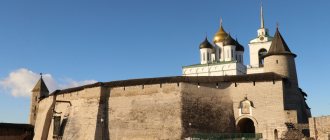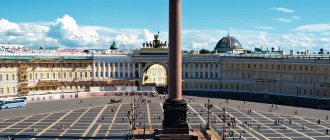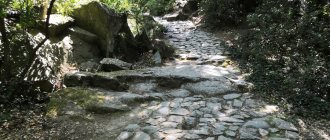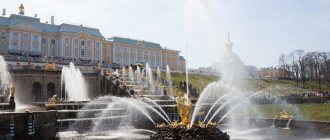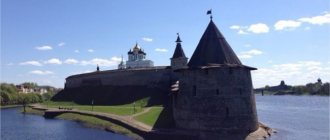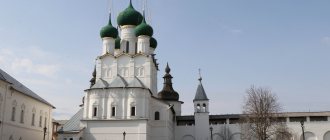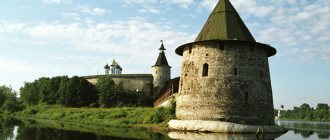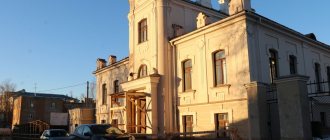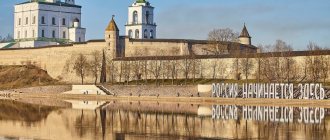> Countries Russia
Pskov is one of the oldest cities in Russia, where unique buildings have been preserved, giving an idea of what medieval Rus' looked like. The rich history has left many architectural and cultural attractions both in the center and in the surrounding area, and many museums. At the same time, the city is actively developing, and new interesting places are appearing. You can expand your trip by visiting ancient monasteries and medieval fortresses in the region or relaxing on the shores of Lake Peipsi. A list of the main points in the center that are easy to get around on foot, as well as travel options nearby, is in this post.
- Sights of Pskov
- Unusual points
- Excursions
- In area
- Museums
- How to get there
- Where to stay
- On the map
In the center
Pskovsky Krom
The Pskov Kremlin (Krom) is the place where Pskov was born in the 10th-11th centuries. At that time, the territory of the Kremlin was relatively small, but gradually new defensive walls appeared around it, and its area increased, dividing the city into Zastenye (behind the first stone walls) and Zapskovye (behind later walls). Impressive fortifications reflected a real need - being located in the very west, on the border with other states, they were constantly under threat of attack and successfully repelled attacks from the Golden Horde, the Livonian Order, Sweden and the State of Lithuania.
Nowadays, inside Krom, the Trinity Cathedral, Dovmontov Castle, the Prikaznye Chambers, as well as defensive walls and towers of the 14th-17th centuries have been preserved. Even today, one is struck by the inaccessibility of the walls, together with the general harmony of the architectural ensemble, rising above the confluence of the Velikaya and Pskova rivers.
st. Kremlin, 2
Opening hours: 06:00 – 22:00
Free admission.
Dovmontov Grad
It’s hard to imagine, but the surviving foundations of 13th-century structures near the Kremlin were discovered only in the 1950s. They allowed us to better understand what architecture was like at that time. It is clearly noticeable that all the buildings stood almost close to each other - as many as ten temples fit into this territory. Next to the foundations is an information board with a picture and description of what they most likely looked like.
Trinity Cathedral
The current 17th-century cathedral is the fourth building on the site of previously burned cathedrals, the first of which was erected by order of Princess Olga. The cathedral, unusually tall for Russian churches, consists of seven tiers, thanks to which it can be seen from different parts of the city. The architecture combines typical Pskov features and features of the Moscow style. Trinity Cathedral is one of the main shrines of the region, where important icons and historical chronicles are kept.
During the time of the Principality of Pskov, a meeting gathered on the square in front of the cathedral, where all important political and social decisions were made. The temple was active until the advent of Soviet power. For some time, an anti-religious museum operated here. Now it belongs to the church again.
Order chambers
The chambers performed an administrative function. Now there is a local history museum. The hipped roof has not been preserved, but a model of the original appearance of the building is inside the museum.
Walls of the Okolny town
The expansion of the Kremlin and fortifications continued due to the walls built in the 16th century around a fairly large area of the current historical center. Surprisingly, most of the walls, three kilometers long, have been preserved and run along modern streets: Kalinin, Sovetskaya and Karl Marx. The complex was also complemented by 50-meter towers, of which only three have survived: Pokrovskaya, Petrovskaya and Mikhailovskaya.
Mirozhsky Monastery
A 12th-century monastery with the only pre-Mongol frescoes preserved in Russia. Soon after its creation, the monastery turned into the cultural center of the city, occupying an increasingly larger area, including the river bank. After the secularization of the lands and the further seizure of the Livonian Order, the territory of the monastery was significantly reduced - approximately to its current size. The oldest and only building that has survived from the founding of the monastery is the Cathedral of the Transfiguration. The remaining buildings date back to the 16th-19th centuries.
Mirozhskaya embankment, 2
Opening hours: Tue-Sun 11:00 – 18:00
Entrance to the monastery territory is free; to church: 200-350 R
Pogankin chambers
One of the oldest residential buildings of the 17th century, which has survived to this day, gives an idea of what the residential buildings of those times looked like. Three multi-storey buildings are built of limestone and whitewashed. There is a legend that the merchant Pogankin, who owned the chambers, walled up his wife in one of the walls. Now the chambers are occupied by the Art Museum-Reserve with an exhibition of paintings.
st. Nekrasova, 7
Opening hours: Tue-Sun 11:00 – 18:00
Entrance: 250 RUR, there are benefits
Cathedral of John the Baptist
One of the oldest Pskov cathedrals is located in the Zavelichye district. The unusual name of the area is due to the fact that it is located on the opposite bank of the Velikaya River from the center. Due to the cultural layer, which has risen by more than a meter, it seems that the temple is gradually going underground. Its architecture displays the features of the Pskov style: simplicity, lack of decoration on the facade and elegance of lines with complete harmony of architectural forms. During Soviet times, the church cemetery was destroyed and the bells were melted down. After a long period of use of the building as a warehouse, a large-scale reconstruction was carried out. Now the appearance of the cathedral is close to the original.
st. Maxim Gorky, 1
Opening hours: 09:00 – 19:00
Free admission
Golden embankment
Golden Embankment is a newly created pedestrian area opposite the Kremlin. There are houses stylized as 19th-century buildings and cafes, but the best thing here is the view of the architectural ensemble of the Kremlin, rising above the confluence of rivers.
Church of Varlaam Khutynsky on Zvanitsa
Like the temple of the same name in Vologda, it received its name in honor of Varlaam Khutynsky, who founded the Spaso-Preobrazhensky Monastery of Novgorod. It was opened in the 15th century to get rid of the plague. The architecture has changed significantly over time, chapels have been added and the roof has been rebuilt.
st. Leona Pozemsky, 53
Free admission.
Embankment of the Velikaya River
Another excellent walking area, completely reconstructed a few years ago. From here you can see the Mirozhsky Monastery and the Zavelichye area.
Church of St. Basil the Great on Gorka
An amazingly beautiful and harmonious temple, rising above a once marshy area. It reflects all the main styles of Pskov architecture of the 15th century: geometric friezes, modest decoration, three-apse structure, whitewashed limestone facade. Unfortunately, the church was heavily rebuilt and the interior was lost, but thanks to its unique architecture, it was included in the UNESCO World Heritage List.
Oktyabrsky p., 5
Free admission
Snetogorsk Monastery
Not far from the center there is a 13th-century monastery - one of the most important shrines in the region. It was here that the princes were tonsured, and unique frescoes were preserved inside, which were whitewashed for a long time and discovered only at the beginning of the 20th century. Surprisingly, the architecture of the cathedral was copied from the main cathedral of the Mirozhsky Monastery, which was a common practice at that time.
Wiki/Commons
st. Snyatnaya Gora, 1
Opening hours: 09:00 – 21:00
Free admission
Pskov Fortress
From the railway station on a local bus we teleport into the thick of things to the Lenin Square stop, where the great Pskov Fortress is waiting for us. While we were driving, here and there we saw the remains of the fortress wall. It felt like you were driving through a labyrinth. The whole secret is that the walls of Pskov Castle were erected in several stages, ring by ring, as the city grew.
The first wall was erected in the X-XI centuries. around the Trinity Cathedral and the veche square. This ring is called the Kremlin or Krom in Old Russian.
The second wall was erected in the 13th century and surrounded the Dovmont city. At that time it was the administrative center of Pskov, named after Prince Dovmont-Timofey, who reigned from 1265 to 1299. It was then that Pskov became a completely independent city and an exemplary medieval fortress.
The third wall was erected in 1309, it was also called the wall of mayor Boris. In 1433, it was dismantled as unnecessary, when the city grew even more, but it seems that it was later rebuilt as part of the global restoration of the fortress. The location landmarks are the Church of Peter and Paul and Profsoyuznaya Street.
The fourth wall was built in 1375. When the previous wall was demolished, the Old and New Zastenye merged into one area, which was called the Middle City, or simply the Zastenye. The total length of the walls at that time already exceeded 1.5 km. At the same time, a new, stronger and higher wall was built along the Pskova River next to the old wall.
The fifth wall was erected in 1465, went to the Zapskovye region along with the Pskovaya River and encircled the Kremlin. The total length of the walls was already 9.5 km. Thus, the fortress became practically impregnable: the secluded Pskovites were not threatened by either hunger or thirst. The new area was called Okolny Gorod. Since the 16th century, wooden walls were gradually replaced with stone ones; to protect them from dampness, they were plastered and roofs were built over them.
The latest version of the Pskov fortress was one of the most powerful not only in Russia, but also in Western Europe. It withstood many attacks and was never taken by storm. Among the most fierce raids were the siege of Pskov by Polish troops in 1581 - 1582, the siege by the Swedes in 1615, and the blockade by tsarist troops in 1650.
Interesting places
Observation deck with Olginskaya Chapel
Not only does it offer the best view of the Kremlin and Trinity Cathedral, but this place is also associated with the legend of the founding of Pskov. According to her, it was here that Princess Olga stood when she saw three connecting beams on the opposite bank. She took this as a sign that this was a good place for the future of the city. On the opposite bank there is the famous inscription “Russia begins here” - one of the symbols of the city. It refers both to the ancient history of Pskov and to the fact that it is located in the very west of the country.
Zapskovye
Once upon a time, the Zapskovye region, adjacent to the center, was inhabited by Germans and other foreigners. Unfortunately, not a single building has survived from those times, and all foreigners were resettled with the annexation of Zapskovye to Pskov. This is the most cozy area with an inexplicable old Russian atmosphere. Ancient churches can be found every now and then on the quiet streets, and residential buildings consist mainly of wooden houses and low-rise residential areas.
It is also worth looking at the Meyer Rope Factory (22 Leona Pozemsky St.), a pre-revolutionary enterprise in the Art Nouveau style. You can get to Zapskovye by walking along the Golden Embankment and turning right.
Rattling Tower
A 14th-century tower on Gremyachaya Mountain, rising above the Pskovaya River. The impressive tower in a quiet place in Zapskovye has always been shrouded in many legends. For example, that the enchanted prince’s daughter is still sleeping inside, and can only be awakened by someone who reads the psalms at her sarcophagus. However, according to legend, as soon as the young men begin to read, evil spirits appear and throw them out of the tower.
Rusinov Chambers
Another example of residential stone buildings from the 17th century. The complex of buildings, including residential buildings, utility and storage facilities, belonged to the Rusinov family, one of the richest local families of that time. Once Peter I, who knew his family, even stayed in the chambers here. Unfortunately, this unique civil building had not been used for several decades and was in a dilapidated state. Now the building is in great ruins, but complete restoration is planned in the coming years.
The Rusinov courtyard is located on one of the busiest streets - Karl Marx Street. A large number of cafes and restaurants are concentrated on it; the city market is located near the embankment, as well as the pedestrian Pushkin Street.
Dovmontov city
Having disembarked at the Lenin Square stop in front of the Rybnitsa Tower, we actually found ourselves at the entrance to the Dovmont city. The tower got its name from the fish rows located nearby. By the way, this is not a real tower, but a reproduction of it. The old Rybnitsa tower was dismantled back in the 1780s, and the current one was rebuilt in 1970-72. when major restoration work was carried out to restore the fortress.
To the left of the Rybnitsa Tower is the Vlasevskaya Tower. The Vlasievo Tower received its name from the Church of Vlasie, which stood next to it from 1373 to 1420. The Vlasyevskaya Tower is also a new building, recreated in 1966. In ancient times, the Vlasyevskaya Tower was the only entrance to the city from the bridge over the Velikaya River, however, the October cinema standing opposite blocked the proper view of the tower, driving it into the lowland, as a result of which the tower lost its grandeur.
In 2010, there was a fire in the Vlasyevskaya tower, which spread to Rybnitskaya, as a result of which the wooden tents burned down and had to be rebuilt.
You can enter the Dovmont city either through the Holy Gate of the Rybnitsa Tower, or a little to the left through the passage near the Prikaznye Chambers.
Immediately at the entrance we are greeted by a souvenir shop, ordering an excursion and a diagram of the Pskov Fortress.
Dovmontov city is named after Prince Dovmont (at the baptism of Timothy), who reigned from 1265 to 1299. Davmont was originally from Lithuania, but in 1265, seeking political asylum, he fled to Pskov with his court and retinue, where he was baptized and soon became the Prince of Pskov. Literally a year later, troops under the command of Dovmont repelled enemy attacks one after another. To commemorate his victories, the prince began to erect temples next to the walls of the Kremlin, which soon led to the construction of a second ring of city fortifications, and the place was nicknamed Dovmont’s city. In total, as Prince Dovmont-Timofey spent 33 years defending and building up the city that sheltered him.
Now all that remains of Dovmont’s city is the foundation, which is not very interesting for a tourist unenlightened in the subtleties of archaeological and historical affairs to look at.
However, all guests of the Pskov Fortress have the opportunity to look at the model of the prosperous Pskov of the late 15th century, where you can clearly see the countless number of churches on the territory of the Dovmont city, of which only the ruins remain, as in the photo above. The museum is located in the bell tower of the Trinity Cathedral.
Rybnitsa Tower from the inside and the ruins of the Cathedral of St. Nicholas on Grebla.
Order chambers (white), Vlasevskaya tower and the ruins of the Dovmont city.
Neighborhood
Pechory
Pechory is a city 50 kilometers from Pskov, where people come primarily for the Pskov-Pechora Monastery. This is one of the oldest monasteries in Russia, founded in the 15th century and since then has never interrupted its work. Since the history of the monastery is extremely rich, it is better to go here on a tour with professional guides. Tours often cover both Pechory and Izborsk - it’s convenient to see both of these places in 1 day.
Izborsk
Izborsk is a small town 30 kilometers in the direction of Pechory. It is considered one of the most ancient cities in Russia, although now it has the status of a village. The main reason to come here is the Izborsk fortress of the 14th century, preserved in very good condition for its advanced age. It’s convenient to get here by bus, car, or with a tour:
Pushkin Mountains
A little further there is a famous and beautiful place - the Pushkin Mountains, located 120 kilometers away. It’s worth devoting at least a whole day to a trip to Pushkin’s places, as they are full of historical sights, and you can learn everything about these places on an individual excursion:
Lake Peipsi
The main lake of the Pskov region, which it shares with Estonia, where it is called Peipsi. It was here that the Battle on the Ice of Alexander Nevsky and the Livonian Order once took place. Now it is a very quiet and peaceful place, and the shore of the lake resembles the shore of the Baltic Sea: sandy beaches surrounded by dense forests. It’s worth a trip here to relax, admire the beautiful scenery, or stay at one of the many coastal resorts.
Wiki/Commons
Smolinskoe Lake
Another picturesque lake in the Palkinsky district. The name comes from the traditional activity of local residents - collecting resin. During the Great Patriotic War, the Germans set up a concentration camp on its banks, traces of which have not survived. Now this is a good direction to go to relax in nature. Smolinskoe Lake is a favorite place for swans, so they are found here quite often.
Museum-estate N.A. Rimsky-Korsakov in Lyubensk
On the way from St. Petersburg, it is convenient to stop by the Rimsky-Korsakov Museum, located not far from Luga in the Plyussky district in the village of Lyubensk. This is an atmospheric place with a restored manor where the composer lived in the last years of his life. The exhibition will tell about these years through personal belongings, household items and a recreated interior.
Pskov Kremlin
After enjoying the views of the ruins, we head to the Kremlin . The height of the Kremlin wall reaches 8 meters and the width is 6 meters. The Kremlin walls are protected by 5 watchtowers: Troitskaya (pictured on the right), Domontova (pictured on the left), Kutekroma, Ploskaya and Srednyaya.
In 1972, a memorial sign was installed on the Kremlin wall in honor of the 730th anniversary of the Battle of the Ice. A shield with the coat of arms and plan of Pskov, round medals with the coats of arms of the city that took part in the Battle of the Ice (Pskov, Novgorod, Vladimir, Tver and Pereslavl-Zalessky) and a sword.
The main gates of the Kremlin are cut through next to the Trinity Tower; they are called the Great or Trinity. Previously, the Kremlin was separated from the city of Dovmont by a deep ditch with a bridge across it. Now everything is much simpler and the usual road leads to the Kremlin.
From the gate one entered first into okhaben (zahab, zakhaben, from Old Russian it means “sleeve”) - a narrow, long corridor sandwiched on both sides by high stone walls, with log battle floors hanging on top, leading to another gate. Thus, the enemy who burst through the first gate found himself in a trap, because he had to storm the next gate, being squeezed by a narrow corridor, under fire from both sides.
Surrounded by formidable walls inside the Kremlin, the Trinity Cathedral .
The first Trinity Cathedral was built in the 10th century from wood. Then it was the main shrine not only of Pskov, but of the entire region, and all important public events took place on the square next to it.
In the 12th century, the Trinity Cathedral was made of stone for the first time and it stood until the ceiling collapsed in 1363, after which the cathedral was dismantled.
In 1367, construction of the third Trinity Cathedral was completed, which stood for just over 300 years.
In 1682, the dilapidated cathedral was rebuilt again, but before the construction was completed, the cathedral collapsed and they had to start all over again. The cathedral was completed only in 1699, and this is the current cathedral. After the Great October Socialist Revolution, the cathedral was closed and a museum of atheism was established there, which was in great demand. The cathedral became operational again after the start of the Great Patriotic War.
And this is what the cathedral looked like in the 15th century:
From the west there is a gently sloping covered staircase leading to the second floor porch. And, lo and behold, photography is allowed in the Trinity Cathedral (without flash).
The outside of the Trinity Cathedral is decorated with glazed tiles and images of vases and flowers. 47 original tiles have been preserved, the rest were made anew.
The bell tower is built on the eastern wall of the Kremlin , however, old drawings and archaeological excavations have shown that it originally stood separately. It is in this form that the bell tower was first recorded in the plan of 1706. In the bell tower there is an exhibition hall with a model of the Kremlin, open daily from 11 to 17 hours.
Next to the Bell Tower is the Middle Tower of the Kremlin. It was also called the Snetnaya Tower, possibly due to the fact that the tower stands on the bank of the river, where small fish - smelt - were traded, and the city's food supplies, weapons, goods, etc. were also stored in it. The tower ends with a watchtower.
In the northernmost part of the Kremlin you can see the Kutekrom Tower , it was the very first one to appear in the Pskov Kremlin and its name is made up of “kut” - corner and “Krom” - Kremlin. However, medieval Pskovites always said separately: “Koster (tower) in the Krom Kut near the Velikaya River.” Presumably the tower was erected in 1400.
Next to the tower there was a secret exit from the Kremlin, blocked with bricks without mortar, which the enemy could not know about. In case of danger, Pskov residents could easily dismantle the bricks and leave the Kremlin.
Kutekrom Tower on a model of the Kremlin of the 15th century.
Next comes the Dovmont Tower , it was also called the Smerdya Tower, from the words smerd, serf, peasant. Initially, there was the only gate leading to the Kremlin, but later the Trinity Gate at the Trinity Tower was broken through.
And here they are - Trinity Gate and Trinity Tower . The Trinity Tower is otherwise also called the Great, Lubyanka and Clock Tower. In 1787, the Clock Tower collapsed and was restored only in 1988. We leave the Kremlin and head into the city.
Museums
Pskov Museum-Reserve
The museum-reserve occupies several historical buildings: the Kremlin, the Prikazny and Pogankin chambers and a branch on Nekrasova Street. Each of them is a branch with its own exposition on various topics. Usually one of the branches is located in the Pogankin Chambers, but now it is closed for restoration.
Branch on Nekrasova
The exhibition is dedicated to ancient Russian culture and the history of the Pskov region during the Second World War.
st. Nekrasova, 7
Opening hours: Tue-Sun 11:00 – 18:00
Entrance: 300 rub.
Order chamber
The museum will tell you about the history of the chambers and what administrative function they played in Rus'. Temporary exhibitions also change here regularly.
Kremlin
Opening hours: Tue-Sun 11:00 – 18:00
Entrance: 150 rub.
Mason's House
The museum occupies an Art Nouveau mansion that once belonged to the Scotsman Mason. The unusual surname turned into the well-known word “Mason”, which is where the name of the house came from. After the revolution, the building was occupied by communal apartments for a long time, until it was occupied by a museum-reserve, placing a storage facility here. There are also exhibitions open to visitors dedicated to the life of local residents of the century before last and heraldry.
Komsomolsky lane, 6
Opening hours: Tue-Sun 11:00 – 17:00
Entrance: 150 rub.
Kaverin Museum
The Kaverin Museum “Two Captains” is dedicated to the famous novel, but will also tell about the life of the writer. Most of the exhibition is devoted to the history of the creation of the novel; items from the musical “Nord-Ost” and the first editions of the novel are collected. The other part consists of the writer’s personal belongings, from which you learn more about his biography. The museum is now temporarily closed for restoration.
Profsoyuznaya st., 2
Free admission.
Railway Museum
Free Russian Railways Museum opposite the main station. It will be of interest to fans of railway transport and railways in Russia.
st. Jan Fabricius, 29
Opening hours: Tue-Sat 11:00-17:00
Free admission.
Zavelichye
You can get to Zavelichye (beyond the Velikaya River) via several bridges, for example, the Olginsky Bridge . The bridge, like many other architectural objects in the area, bears the name of Princess Olga, who is considered the patroness of Pskov.
There is a beautiful legend about the emergence of the city, according to which Pskov was founded by Princess Olga. Being the daughter of a poor peasant, the future princess worked at the crossing and transported people by boat. One of those who once crossed the river with Olga was the young Prince Igor. He instantly fell in love with a beautiful girl and soon married her. Already as a princess, Olga once sailed along the Velikaya River on a boat and admired the beautiful hill rising above the confluence of the smaller Pskova River into the Velikaya River. Suddenly a strong wind blew and the sky became cloudy. Then Olga came down to earth and began to pray. Suddenly the heavens opened up, and three rays appeared before the young princess, which converged on the very place where in the future the main Pskov temple - the Trinity Cathedral - would be built. Impressed by the fantastic vision, Olga ordered a church to be built here and a city to be founded.
Many places in the city are named after Princess Olga, for example, the Olginsky Bridge, Olginskaya Embankment, Olginsky Cross, Olginsky Well, the Chapel of Princess Olga, the monument to Princess Olga, and even the Olginskaya cafe and the Olginsky business center.
The Olga Chapel was built at the beginning of the 19th century, presumably exactly where the princess watched the luminous rays.
In the 1960s The chapel was demolished and a new one was built only in 2000. It’s a pity that the beautiful paving stones were also demolished along with the chapel.
Of course, it’s worth crossing the bridge, if not for the chapel, then at least for the beautiful panoramic view of the huge Pskov Fortress.
Fortress wall and embankment of the Velikaya River:
And here is the Olginsky Bridge itself, it looks quite sad.
For comparison, the same bridge on the old postcard, albeit from a different angle.
In the foreground is the Anastasyevskaya Chapel . It was originally made of wood and stood for about 200 years; the chapel was rebuilt in stone in 1911. The chapel still stands in the same place, though in a low place, among wasteland and fences, and it doesn’t even look like you can go into it.
On the other side of the bridge you can see the Assumption Paromena Church and a beautiful bell tower, which housed a workshop and a forge in the 1960-1980s. The church was first mentioned in chronicles in 1444. Previously, instead of the Olginsky Bridge, there was a floating bridge and a ferry moored here, for which the church was called Paromenskaya.
Walking along the Olginskaya embankment, we see that the old houses in the area look quite sad: they are all covered in cracks and patches, and are about to fall apart.
And the new building, as always, is ridiculous and ridiculous.
The intersection of Rizhsky Prospekt and Maxim Gorky streets. Dilapidated Stalinka.
This one had its bottles painted, but what about the rest?
Public transport in Pskov consists of only buses:
Where to stay
Pskov has quite a large selection of housing that will suit any budget. For budget travelers, hostels are a great option for one night. The best hostels: Hostel - Pskov, Happy Slud (I personally stayed there, a good option right next to the station), Petrovsky.
The best value for money is found in apartments and hotels in the center: Apartment on ulitsa Gogolya 7 B, Greenfeel Hotel, On Sovetskaya.
The most convenient way to find the best accommodation options is on Hotellook
Pskov railway station
Speaking of buses. Buses run from Pskov to Estonia and Latvia.
There is also a railway line passing through Pskov, but trains do not go abroad, and the Pskov-Passenger station is the final station. This station was built in 1859 during the Russian Empire to connect the Russian and Baltic lands.
Tips for staying in the city
Pskov is a rather large city, and all the main attractions are located in the central part. Therefore, when choosing a hotel, it is better to choose options located in the center. You can come to the city at any time of the year. All museums and attractions are open to the public in winter, summer, and off-season. However, the most popular time of year for tourists to visit Pskov is, of course, summer. It is during the warm season that most travelers gather here, but this will not affect comfort in any way: there are still no long queues to attractions and museums. The air temperature in the city barely exceeds 20 degrees, but heavy downpours are common, so it is better to take an umbrella or raincoat with you on your trip.
Summer Pskov rain can flood roadways and pedestrian areas of the city
What to bring as a souvenir
In addition to standard souvenirs, you can bring from Pskov:
- Ceramic products. Pskov ceramics are known not only throughout Russia, but also abroad. The souvenir will be a pleasant and useful gift, because ceramic dishes can be used in everyday life.
, produces homemade, cute dishes that create incredible comfort in the kitchen - Forged souvenirs. Forging is another calling card of Pskov. Local craftsmen won the trust of Peter I himself, who at one time noted the increased functionality of local forged products. As a souvenir you can buy a small belfry, a coin or a forged magnet.
- Gifts made from linen. Linen towels, tablecloths, shirts and much more can be purchased in Pskov as gifts for loved ones. Some craftsmen hand weave thin lace from flax and decorate it with patterns and intricate embroidery.
- Religious souvenirs. In the city, which is home to more than thirty temples, religious souvenirs are especially popular. In church shops at churches and monasteries you can buy icons, crosses, prayer books and much more.
